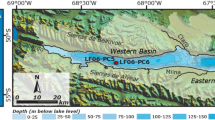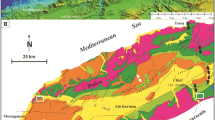Abstract
The geochemistry of limestone from Nkapa and Logbajeck formations, Douala sub-basin, has been studied using major, trace elements and stable isotopes in order to decipher paleo-redox condition, depositional and post-depositional imprints and paleotemperature. Collectively, U/Th Ni/Co, V (V + N), V/Cr and Ce/Ce* ratios clearly indicate an oxic depositional condition for the samples. The ratios of Mn/Sr suggest less significant diagenetic alteration on limestone composition. The carbon isotopic signals δ13C ranged from − 0.26 to 0.86‰ PDB while oxygen isotope δ18O is from − 2.24 to − 7.94‰.‰ PDB. The isotopic composition of δ13C (− 1.9 to 0.79‰) shows a discrepancy from modern carbonate sediments. The poor correlation and scattered distribution of δ13C versus δ18O plot in calcareous sediments reflect different degrees of burial diagenesis and/or the potential impact of meteoric water. The average estimated temperature of formation for the limestone is 44.08 °C revealing a warm period during its deposition. The paleosalinity values (Z) for the studied area vary from 111.45 to 127.11‰ indicating a marine to fresh water depositional environment. The δ13O versus δ18O bivariate diagram indicates that the limestone is predominantly marine limestone, freshwater limestone, late cement and Pleistocene limestone.






Similar content being viewed by others
Data Availability
All data used in this study will be readily available to the public.
References
Alam MS, Keppens E, Paepe R (1997) The use of oxygen and carbon isotope composition of pedogenic carbonates from Pleistocene palaeosols in NW Bangladesh, as palaeoclimatic indicators. Quatern Sci Rev 16:161–216
Allan JR, Matthews RK (1982) Isotope signatures associated with early meteoric diagenesis. Sedimentology 29:797–817
Armstrong-Altrin JS, Lee YI, Verma SP, Worden RH (2009) Carbon, oxygen, and strontium isotope geochemistry of carbonate rocks of the upper miocene Kudankulam formation, Southern India: implications for paleoenvironment and diagenesis. Chem Erde Geochem 69:45–60
Armstrong-Altrin JS, Madhavaraju J, Sial AN, Kasper-Zubillaga JJ, Natarajan R, Flores-Castro K, Rodriguez Jl (2011) Petrography and stable isotope geochemistry of the cretaceous El Abra limestones (Actopan), Mexico: implication on diagenesis. J Geol Soc India 77(4):349–359
Armstrong-Altrin JS, Nagarajan R, Balaram V, Natalhy-Pineda O (2015) Petrography and geochemistry of sand from the chachalacas and veracruz beach areas, western gulf of Mexico, Mexico: constraints on provenance and tectonic setting. J South Am Earth Sci 64:199–216
Bellanca A, Calvo JP, Neri R, Mirto E (1995) Lake margin carbonate deposits of Las Minas Basin, upper Miocene, Southeastern Spain. A sedimentological and geochemical approach to the study of lacustrine and palustrine paleoenvironments. Miner Petrogr Acta 38:113–128
Brownfeld ME, Charpentier RR (2006) Geology and total petroleum systems of the West-Central Coastal Province (7203), West Africa. U.S. Geological Survey Bulletin 2207-B, pp. 1–52
Bukalo N, Ekosse GI, Odiyo J, Ogola J (2019) Paleoclimatic implications of hydrogen and oxygen isotopic compositions of Cretaceous-Tertiary kaolins in the Douala Sub-Basin Cameroon. C R Geosci 351(1):17–26
Buonocunto FP, Sprovieri M, Bellanca A, D’Argenio B, Ferreri V, Neri R, Ferruzza G (2002) Cyclostratigraphy and high-frequency carbon isotope fluctuations in upper Cretaceous shallow-water carbonates, Southern Italy. Sedimentology 49:1321–1337
Cox R, Low DR, Cullers RL (1995) The influence of sediment recycling and basement composition on evolution of mudrock chemistry in the Southwestern United States. Geochem Cosmochem Acta 59(14):2919–2940
Crne AE, Melezhik VA, Lepland A, Fallick AE, Prave AR, Brasier AT (2014) Petrography and geochemistry of carbonate rocks of the Zaonega formation, Russia: documentation of 13C-depleted non-primary calcite. Precambrian Res 240:79–93
Cuna S, Pop D, Hosu A (2001) Crabon and oxygen isotope ratio in Rona limestone Romania. Environ Sustain Geol 46(1):139–152
Epstein S, Buchsbaum R, Lowenstam HA, Urey HC (1953) Revised carbonate-water isotopic temperature scale. Geol Soc Am Bull 64:1315–1326
Esue MF, Agyingi CM, Foba-Tendo J, Lordon AE (2021) Geochemistry of carbonate-clastic strata in NW Douala sub-basin Cameroon: Implications for provenance tectonics and source area weathering. J Sediment Environ 6(1):57–71. https://doi.org/10.1007/s43217-020-00044-1
Friedman I, ONeil JR (1977) Compilation of stable isotope fractionation factors of geochemical interest. U.S. Geol Surv, Prof. Paper 440K, p 12
Gromet LP, Dymek RF, Haskin LA, Korotev RV (1984) The North American shale composite: its composition, major and trace element characteristics. Geochim Cosmochim Acta 48:2469–2482. https://doi.org/10.1016/0016-7037(84)90298-9
Hu J, Li Q, Li J, Huang J, Ge D (2015) Geochemical characteristics and depositional environment of the Middle Permian mudstones from central Qiangtang basin, Northern Tibet. Geol J 51:560–571
Hudson JD (1977) Stable isotopes and limestone lithification. J Geol Soc Lond 133:637–660
Jones B, Manning DAC (1994) Comparison of geological indices used for the interpretation of palaeoredox conditions in ancient mudstones. Chem Geol 111:111–129
Kim ST, Coplen TB, Horita J (2015) Normalization of stable isotope data for carbonate minerals: implementation of IUPAC guidelines. Geochem Cosmochim Acta 158:276–289
Kwankam FN, Agyingi CM, Foba-Tendo J, Suh CE (2021) Geochemistry of sedimentary rocks from the nkapa formation north western part of the douala basin cameroon: implications for provenance tectonic setting and paleoenvironmental conditions. Int J Geosci 12(09):739–762. https://doi.org/10.4236/ijg.2021.129042
Lewan MD (1984) Factors controlling the proportionality of vanadium to nickel in crude oils. Geochimica Cosmochim Acta 48(11):2231–2238
Loule JP, Jifon F, Bioule SEA, Nguema P, Spofforth D, Carruthers D, Johnston J (2018) An opportunity to re-evaluate the petroleum potential of the Douala/Kribi-Campo Basin, Cameroon. First Break 36(3):61–70
Madhavaraju J (2015) Geochemistry of late cretaceous sedimentary rocks of the Cauvery basin, South India: constraints on paleoweathering, provenance, and end cretaceous environment. Chemostratigraphy 124:185–214
Manga CS (2008) Stratigraphy, structure and prospectivity of the Southern onshore Douala Basin, Cameroon—Central Africa. Africa Geosci Rev 1,2:13–17
Marshall JD (1992) Climatic and oceanographic isotopic signals from the carbonate rock record and their preservation. Geol Mag 129:143–160
Mckenzie JA (1981) Holocene dolomitization of calcium carbonate sediments from the coastal Sabkhas of Abu Dhabi, U.A.E.: a stable isotope study. J Geol 89:185–198
Meyers JB, Rosendahl BR, Groschel-Becker H, Austin JJA, Rona PA (1996) Deep penetrating MCS imaging of the rift-to-drift transition, offshore Douala and North Gabon Basins, West Africa. Mar Pet Geol 13:791–835
Mfayakouo BC, Ngaha PRN, Bitom DL (2021) Age and paleo-environmental evolution of the Douala basin (Cameroon) during the Cenozoic: insights from palynology and sequence analysis. Heliyon. https://doi.org/10.1016/j.heliyon.2021.e08514
Milliman JD, Muller J (1977) Characteristics and genesis of shallower water and deep sea limestones. In: Anderson NR, Maahoff A (eds) The fate of fossil fuel CO2 in the Oceans. Plenum, New York, pp 655–672
Mosoh Bambi CK, Frimmel HE, Zeh A, Suh CE (2013) Age and origin of Pan-African granites and associated U-Mo Mineralization at Ekomédion, Southwestern Cameroon. J Afr Earth Sci 88:15–37
Murray RW, Brink MRB, Brumsack HJ, Gerlack CD, Russ PG III (1991) Rare earth elements in Japan Sea sediments and diagenetic behavior of Ce/Ce*: results from ODP Leg 127. Geochim Cosmochrmica Acta 55:2453–2466
Nagarajan R, Armstrong-Altrin JS, Nagendra R, Madhavaraju J, Moutte J (2007) Petrography and geochemistry of terrigenous sedimentary rocks in the Neoproterozoic Rabanpalli formation, Bhima basin, Northern Karnataka, Southern India: implications for paleoweathering condition, provenance, and source rocks composition. J Geol Soc India 70:297–312
Nagarajan R, Armstrong-Altrin JS, Sial AN, Nagendra R, Ellam RM (2013) Carbon, oxygen, and strontium isotope geochemistry of the Proterozoic carbonate rocks, Bhima basin, South India: implication for diagenesis. Carpathian J Earth Environ Sci 8(2):25–38
NagarajanArmstrong-AltrinKesslerHidalgo-Moral RJSFEL, Dodge-Wan D, Taib NI (2015) Provenance and tectonic setting of Miocene siliciclastic sediments, Sibuti formation, Northwestern Borneo. J Geosci 8(10):8549–8565. https://doi.org/10.1007/s12517-015-1833-4
Nagarayan R, Sial AN, Armstrong-Atrin JS, Madhavaraju J, Nagendra R (2008) Carbon and oxygen isotope geochemistry of Neoproterozoic limestones of the Shahabad formation, Bhima basin, Karnataka, Southern India. Rev Mex Cienciasgeol 25(2):225–235
Nath BN, Bau M, Ramalingeswara Rao B, Rao CM (1997) Trace and rare earthelemental variation in Arabian Sea sediments through a transect across the oxygen minimum zone. Geochim Cosmochim Acta 61(12):2375–2388
Ngueutchoua G, Ngantchu LD, Youbi M, Ngos S III, Beyala VKK, Yifomju KP, Tchamgoué JC (2017) Geochemistry of cretaceous mudrocks and sandstones from Douala sub-basin, Kumba area, South West Cameroon: constraints on provenance, source rock weathering, paleo-oxidation conditions and tectonic environment. Int J Geosci 8:393–424. https://doi.org/10.4236/ijg.2017.84021,13,312-317
Njiké Ngaha PR (1984) Contribution à l’Etude Géologique, Stratigraphique et Structurale de la Bordure du Bassin Atlantique du Cameroun. Thèse 3ème Cycle, Université de Yaoundé, Cameroun
Ntamak-Nida MJ, Bourquin S, Makong JC, Baudin F, Mpesse JE, Komguem PB, Ablolo GM (2010) Sedimentology and sequence stratigraphy from outcrops of Kribi-Campo sub-basin: mundeck formation (lower Cretaceous, Southern Cameroon). J Afr Earth Sci 58:1–18
Obasi RA, Talabi AO, Madukwe H (2018) Rare earth element geochemistry of stream sediments from pegmatite terrain of Ijero-Ekiti, Southwestern Nigeria: implications for source rocks and paleo-oxidation conditions. Int J Basic Appl Sci 18(2):8–18
Ozkan AM (2019) Geochemical features of rare earth elements in the dolomites of the Bozdag formation (early Silurian–middle Devonian) from ladik (Konya/Turkey) area. Int J Eng Sci 8(8):30–46
Quade J, Garzione C, Eiler J (2007) Paleoelevation reconstruction using pedogenic carbonates. Rev Mineral Geochem 66:53–87
Reyment RA (1954) The stratigraphy of the Southern Cameroons. Geol Foren Hanl Bd 76(4):661–683
Rimmer SM (2004) Geochemical Paleoredox Indicators in Devonian-Mississippian black Shales, central appalachian basin (USA). Chem Geol 206:373–391
Rollinson HS (1993) Using geochemical data: evaluating, presentation, interpretation (chemistry series). Pearson Prentice Hall, p 384
Samuel J, Rouault R, Besnus Y (1985) Analyse multiélémentaire standardisée des matériaux géologiques en spectrometrie d’emission par plasma à couplage indutif. Analusis 13:312–317
Singh AK, Tewari VC, Sial AN, Khanna PP, Singh NI (2016) Rare earth elements and stable isotope geochemistry of carbonates from the melange zone of Manipur ophiolitic complex, indo-Myanmar orogenic belt, Northeast India. Carbonates Evaporites 31(2):139–151
Somayajulu BLK, Yadav DN, Sarin MM (1994) Recent sedimentary records from the Arabian sea. Proc Indian Acad Sci 103:315–327
Suttner LJ, Dutta PK (1986) Alluvial sandstone composition and paleoclimate I framework mineralogy. J Sediment Pet 56:329–345
Tagne-Kamga G (2003) Petrogenesis of the Neoproterozoic ngondo plutonic complex (Cameroon, West Central Africa): a case of late-collisional ferro-potassic magmatism. J Afr Earth Sci 36:149–171
Taylor SR, McLennan SM (1985) The continental crust: its composition and evolution. Blackwell, Oxford
Veizer J (1983) Chemical diagenesis of carbonates; theory and application of trace element technique. In: Arthur MA, Anderson TF, Kaplan IR, Veizer J, Land LS (eds) Stable isotopes in sedimentary geology, 3–1. Society of Economic Palaeontologists and Mineralogists, pp 3–100
Wantim MN, Suh EC, Ernst GGJ, Kervyn M, Jacobs P (2011) Characteristics of the 2000 eruption fissures and lava flow fields at Mount Cameroon volcano, West Africa. Geol J 46:344–363
Weber JN, Raup DM (1968) Comparison of 13C/I2C and I8O/ I6O in the skeletal calcite of recent and fossil echinoids. J Paleontol 42:37–50
Acknowledgements
This paper is part of the PhD thesis of Ndengwe Alexander Tangwa at the University of Bamenda, Department of Geology, Mining and Environmental Science. The authors are thankful to the Stable Isotope Laboratory, University of Wyoming (USA), for stable isotope analyses. This research did not receive any specific grant from funding agencies in the public, commercial or not-for-profit sector.
Funding
This research did not receive any specific grant from funding agencies in the public, commercial or not-for-profit sector.
Author information
Authors and Affiliations
Contributions
NAT participated in the project design, did the field work, sample collection, sample processing, data interpretation and compilation and conceived and wrote the manuscript draft. NOA conceived the project, developed the field work strategy, analytical techniques used and the general data interpretation. Edited, read and amended the manuscript. NNY edited, read and amended the manuscript. All authors read and approved the manuscript.
Corresponding author
Ethics declarations
Conflict of interest
The authors declare no conflict of interest/competing interest.
Additional information
Publisher's Note
Springer Nature remains neutral with regard to jurisdictional claims in published maps and institutional affiliations.
Rights and permissions
Springer Nature or its licensor (e.g. a society or other partner) holds exclusive rights to this article under a publishing agreement with the author(s) or other rightsholder(s); author self-archiving of the accepted manuscript version of this article is solely governed by the terms of such publishing agreement and applicable law.
About this article
Cite this article
Tangwa, N.A., Anoh, N.O. & Njamnsi, N.Y. Geochemistry of Limestone from the Douala Sub-basin, Cameroon: Implications on Diagenesis, Depositional Environment and Paleotemperature. Aquat Geochem 29, 127–143 (2023). https://doi.org/10.1007/s10498-023-09413-4
Received:
Accepted:
Published:
Issue Date:
DOI: https://doi.org/10.1007/s10498-023-09413-4




